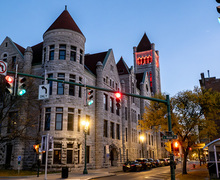Health & Science : Under the sea: Team goes on underwater expedition to explore mountain chain
Jeffrey Karson plunged deep into the unknown this month with Aleece Nanfito and Darcy Joyce as they participated in an expedition that explored the deep sea floor off the coast of Portugal.
The team was aboard the E/V Nautilus, a research vessel 64 meters long, operated by the Ocean Exploration Trust, as well as the National Oceanic and Atmospheric Administration and the National Geographic Society, according to an Oct. 10 SU press release.
Karson, who is both a Jessie Page Heroy Professor and chair of the earth science department at Syracuse University, served as chief scientist on board the vessel from Oct. 8-19. Nanfito graduated from SU in May and Joyce is a junior earth science major.
Karson’s goal for the voyage was to use the remote-controlled vehicles Hercules, Argus, Diana and Echo to explore the mountain chain along the bottom of the ocean known as the Gorringe Bank, he said.
The expedition was revolutionary because the vehicles could descend 4,000 meters below the surface and contained several cameras and sensors used to compile data for the scientists, Karson said. These vehicles made it possible for the ships to broadcast the video 24 hours a day onto the Nautilus Live website, where the public could watch every dive live and listen to researcher’s comments.
‘For anyone who tuned in, it was almost like being on the ship — except you’re not rocking around, and you can go home at night instead of down to a cabin,’ Karson said.
The Gorringe Bank, about 150 nautical miles west of Portugal, contains a peak known as the Gettysburg Seamount, formed from calcium carbonate crystals that grew on top of one another to form the huge mountain structures. Many nearly reach the surface of the water and may have been above sea level in the past before they eroded off, Karson said.
Karson and scientists on board were particularly interested in Gettysburg due to its unique formation from rocks of the earth’s mantle colliding with seawater to form the crystals, known as venting.
Such a formation has only been seen at one location of the ocean floor, in an area called Lost City, discovered in 2000, Karson said. The material dates to 143 million years ago and was likely formed by the separation of Europe and North America, he said.
One of the main goals Karson and his fellow researchers have is to find a second example of this rare occurrence.
‘It was really a shot in the dark in a lot of ways, we had no idea if we would be able to find that stuff,’ he said. ‘It was the kind of place where it might happen since all the ingredients were there, and so we were very eager to explore the area and see what we might find.’
The team was not able to find the vents it were looking for due to technical difficulties, such as problems with the fiber optic cable and the ship’s propulsion system, but still discovered different corals, fish and several geological relationships. Rocks from the exploration will be sent back to Syracuse in a few weeks.
‘Even though we were sort of prospecting for these kinds of hydrothermal vents using what we learned at this Lost City site, we were also sort of looking to see what was there,’ Karson said. ‘It was just like going to another planet, or a place no one’s seen before.’
As a student aboard the ship, Joyce was able to conduct research, take samples and troubleshoot during the days when the fiber optic cable wasn’t functioning properly. She chose to go on the trip to explore marine geology, a concentration she was considering for her major.
Joyce is in the midst of choosing a topic to research based off the trip. She spent her time on board doing different activities during her two four-hour watches a day, she said.
‘During off time, we caught up on sleep, examined samples brought up by Hercules and played cards on the deck,’ she said. ‘We even had a few swim calls — there’s nothing like swimming in the middle of the Atlantic.’
Published on October 24, 2011 at 12:00 pm
Contact Marwa: meltagou@syr.edu | @marwaeltagouri





